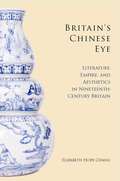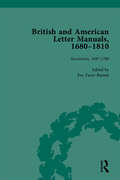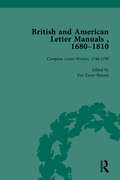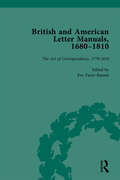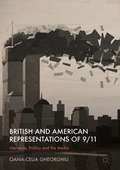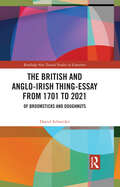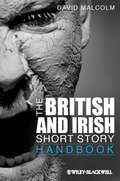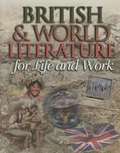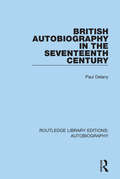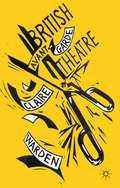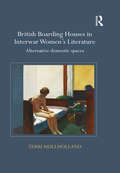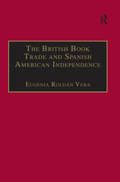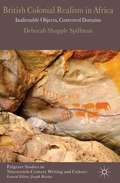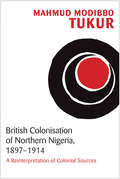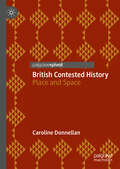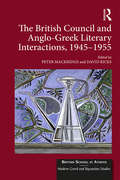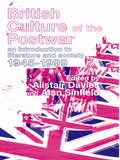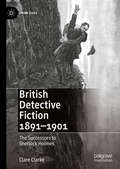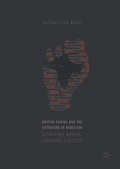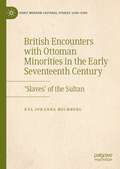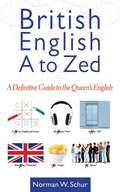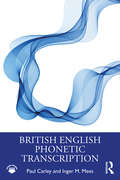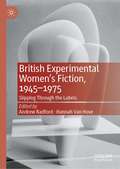- Table View
- List View
Britain's Chinese Eye
by Elizabeth Hope ChangThis book traces the intimate connections between Britain and China throughout the nineteenth century and argues for China's central impact on the British visual imagination. Chang brings together an unusual group of primary sources to investigate how nineteenth-century Britons looked at and represented Chinese people, places, and things, and how, in the process, ethnographic, geographic, and aesthetic representations of China shaped British writers' and artists' vision of their own lives and experiences. For many Britons, China was much more than a geographical location; it was also a way of seeing and being seen that could be either embraced as creative inspiration or rejected as contagious influence. In both cases, the idea of China's visual difference stood in negative contrast to Britain's evolving sense of the visual and literary real. To better grasp what Romantic and Victorian writers, artists, and architects were doing at home, we must also understand the foreign "objects" found in their midst and what they were looking at abroad.
Britain's Chinese Eye: Literature, Empire, and Aesthetics in Nineteenth-Century Britain
by Elizabeth Hope ChangThis book traces the intimate connections between Britain and China throughout the nineteenth century and argues for China's central impact on the British visual imagination.
British and American Letter Manuals, 1680-1810, Volume 2
by Eve Tavor BannetDuring the 18th century, letter manuals became the most popular form of conduct literature. They were marketed to and used by a wide spectrum of society, from maidservants and apprentices, through military officers and merchants, to gentlemen, parents and children. This work presents the most influential manuals from both sides of the Atlantic.
British and American Letter Manuals, 1680-1810, Volume 3
by Eve Tavor BannetDuring the 18th century, letter manuals became the most popular form of conduct literature. They were marketed to and used by a wide spectrum of society, from maidservants and apprentices, through military officers and merchants, to gentlemen, parents and children. This work presents the most influential manuals from both sides of the Atlantic.
British and American Letter Manuals, 1680-1810, Volume 4
by Eve Tavor BannetDuring the 18th century, letter manuals became the most popular form of conduct literature. They were marketed to and used by a wide spectrum of society, from maidservants and apprentices, through military officers and merchants, to gentlemen, parents and children. This work presents the most influential manuals from both sides of the Atlantic.
British and American Representations of 9/11: Literature, Politics and the Media
by Oana-Celia GheorghiuThis book argues that twenty-first-century neorealist fiction is inspired by political and journalistic discourses and, along with them, constitutes one of the many representations of the attacks on September 11 and their outcomes. Adopting a neorealist stance, this book is placed at the intersection of realism and fiction, with often reference to what is perceived as objective writing (media and political texts), not at all so divorced from the practice of literary writings on the event that shook the world on September 11, 2001.
The British and Anglo-Irish Thing-Essay from 1701 to 2021: Of Broomsticks and Doughnuts (Routledge New Textual Studies in Literature)
by Daniel SchneiderWhile the it-narrative, the thing-poem and thing theatre have been around for some time, the essay – which is often considered literature’s fourth genre – is still lacking its thing-subgenre. Yet, particularly British and Anglo-Irish literature display a long, albeit so far implicit tradition of texts that can be categorised as ‘thing-essays’: Starting with Jonathan Swift’s “Meditation upon a Broomstick” (1701) and continuing until today, these texts draw broader insights from the contemplation of a material item of daily life. This book provides the first theoretical conceptualisation of this genre. Bringing elements from essay studies and the New Materialisms together, it shows why the essay lends itself particularly well to literarisations of the personal relationships that people foster to everyday objects. While the idiosyncrasies of each essay show the versatility of thing-essays, the study also seeks to unearth changing attitudes towards things – and thus towards people’s material surroundings in general – throughout time. In order to account for such synchronic and diachronic differences in thing-essays, this study develops a typology of three modes via which things can be approached essayistically. In the book’s second part, this framework will be employed in close readings and historicisations of 14 thing-essays from 1701 until 2021. Ranging from satire to sentimental writing, from religion to consumerism, from class to gender differences, from feelings of nationality to exoticism, from the French Revolution to Freud and from art to everyday life, the stylistic and thematic broadness of these thing-essays ultimately shows the multifarious connections between human life and materiality.
The British and Irish Short Story Handbook (Wiley Blackwell Literature Handbooks #33)
by David MalcolmThe British and Irish Short Story Handbook guides readers through the development of the short story and the unique critical issues involved in discussions of short fiction. It includes a wide-ranging analysis of non-canonical and non-realist writers as well as the major authors and their works, providing a comprehensive and much-needed appraisal of this area. Guides readers through the development of the short story and critical issues involved in discussions of short fiction Offers a detailed discussion of the range of genres in the British and Irish short story Includes extensive analysis of non-canonical writers, such as Hubert Crackanthorpe, Ella D’Arcy, T.F. Powys, A.E. Coppard, Julian Maclaren-Ross, Mollie Panter-Downes, Denton Welch, and Sylvia Townsend Warner Provide a wide-ranging discussion of non-realist and experimental short stories Includes a large section on the British short story in the Second World War
British and World Literature for Life and Work
by Christine Bideganeta Larocco Elaine Bowe JohnsonThe four-volume Literature for Life and Work series continues with British and World Literature for Life and Work(Grade 12). This book challenges students to think critically, work together in teams, and reflect on universal themes by using selections from British and world literature.
British Autobiography in the Seventeenth Century (Routledge Library Editions: Autobiography #1)
by Paul DelanyOriginally published in 1969. In the seventeenth century neither the literary genre nor the term ‘autobiography’ existed but we see in seventeenth-century literature many kinds of autobiographical writings, to which their authors gave such titles as ‘Journal of the Life of Me, Confessions, etc. This work is a study of nearly two hundred of these, published and unpublished, which together represent a very varied group of writings. The book begins with an examination of the rise of autobiography as a genre during the Renaissance. It discusses seventeenth-century autobiographical writings under two main headings – ‘religious’, where the autobiographies are grouped according to the denomination of their writer, and ‘secular’, where a wide variety of writings is examined, including accounts of travel and of military and political life, as well as more personal accounts. Autobiographies by women are treated separately, and the author shows that they in general have a deeper revelation of sentiments and more subtle self-analyses than is found in comparable works by men. Sources and influences are recorded and also the essential historical details of each work. This book gives a critical analysis of the autobiographies as literary works and suggests relationships between them and the culture and society of their time. Review of the original publication: "…a contribution to cultural history which is of quite exceptional merit. Its subject is of great intrinsic interest and manifest importance and Professor Delany has treated it with exemplary thoroughness, lucidity, and intelligence." Lionel Trilling
British Avant-Garde Theatre
by Claire WardenThis book explores an under-researched body of work from the early decades of the twentieth century, connecting plays, performances and practitioners together in dynamic dialogues. Moving across national, generational and social borders, the book reads experiments in Britain during this period alongside theatrical innovations overseas.
British Boarding Houses in Interwar Women's Literature: Alternative domestic spaces
by Terri MullhollandEmbraced for the dramatic opportunities afforded by a house full of strangers, the British boarding house emerged as a setting for novels published during the interwar period by a diverse range of women writers from Stella Gibbons to Virginia Woolf. To use the single room in the boarding house or bedsit, Terri Mullholland argues, is to foreground a particular experience. While the single room represents the freedoms of independent living available to women in the early twentieth century, it also marks the precariousness of unmarried women’s lives. By placing their characters in this transient space, women writers could explore women's changing social roles and complex experiences – amateur prostitution, lesbian relationships, extra-marital affairs, and abortion – outside traditional domestic narrative concerns. Mullholland presents new readings of works by canonical and non-canonical writers, including Stella Gibbons, Winifred Holtby, Storm Jameson, Rosamond Lehmann, Dorothy Richardson, Jean Rhys, and Virginia Woolf. A hybrid of the modernist and realist domestic fiction written and read by women, the literature of the single room merges modernism's interest in interior psychological states with the realism of precisely documented exterior spaces, offering a new mode of engagement with the two forms of interiority.
The British Book Trade and Spanish American Independence: Education and Knowledge Transmission in Transcontinental Perspective
by Eugenia Roldán VeraThe British Book Trade and Spanish American Independence is a pioneering study of the export of books from Britain to early-independent Spanish America, which considers all phases of production, distribution, reading, and re-writing of British books in the region, and explores the role that these works played in the formation of national identities in the new countries. Analysing in particular the publishing house of Rudolph Ackermann, which dominated the export of British books in Spanish to the former colonies in the 1820s, it discusses the ways in which the printed form of these publications affected the knowledge conveyed by them. After a survey of the peculiar characteristics of print culture in early-independent Spanish America and the trends in the import of European books in the region, the author examines the operation of Ackermann's publishing enterprise. She shows how the collaborative nature of this enterprise, involving a number of Spanish American diplomats as sponsors and Spanish exiles as writers and translators, shaped the characteristics of its publications, and how the notion of 'useful knowledge' conveyed by them was deployed in the service of both commercial and educational concerns. The hitherto unexplored mechanisms of book import, distribution, wholesale and retailing in Spanish America in the 1820s are also analysed as is the way in which the significance of the knowledge transmitted by those books shifted in the course of their production and distribution. The author examines how the question-and-answer form of Ackermann's textbooks constrained both publishers and writers and oriented their readers' relation with the texts. She then looks at the various ways in which foreign knowledge was appropriated in the construction of individual, social, national, and continental identities; this is done through the study of a number of individual reading experiences and through the analysis of the editions and adaptations of Ackermann's textbooks during the nineteenth century.
British Colonial Realism in Africa
by Deborah Shapple SpillmanHow are objects central to the formation of individuals, their communities, and their liberties? What role do objects play as they move between societies and their different systems of value as commodities, as charms, as gifts, as trophies, or as curses? Nineteenth-century British authors attempting to transport narrative realism to the colonies confronted such questions directly and indirectly as they struggled to represent competing forms of material investment that characterized colonial and postcolonial life in Africa. Reading works by authors from Joseph Conrad and Mary Kingsley to Anna Howarth and Olive Schreiner against nineteenth-century African essays, folklore, visual arts, and recorded testimonies, this new study considers how conflicts over the material world impacted literary realism in colonial Africa. These conflicts highlight tensions between Victorian and African perceptions of objects and practices of exchange, while directing our attention toward alternate histories and stories yet to be told.
British Colonisation of Northern Nigeria, 1897-1914: A Reinterpretation of Colonial Sources
by Mahmud Modibbo Tukur Michael J. Watts"In this densely detailed and interpretatively nuanced study, Mahmud Modibbo Tukur lays bare the very foundations of the colonial state in what is now northern Nigeria. This is a must read for anyone wanting to understand the foundations of contemporary Nigeria and how we came to be what we are." - Prof. Abdul Raufu Mustapha, University of Oxford, UK. Mahmud Modibbo Tukur's work challenges fundamental assumptions and conclusions about European colonialism in Africa, especially British colonialism in northern Nigeria. Whereas others have presented the thesis of a welcome reception of the imposition of British colonialism by the people, the study has found physical resistance and tremendous hostility towards that imposition; and, contrary to the "pacification" and minimal violence argued by some scholars, the study has exposed the violent and bloody nature of that occupation. Rather than the single story of "Indirect rule", or "abolishing slavery" and lifting the burden of precolonial taxation which others have argued, this book has shown that British officials were very much in evidence, imposed numerous and heavier taxes collected with great efficiency and ruthlessness, and ignored the health and welfare of the people in famines and health epidemics which ravaged parts of northern Nigeria during the period. British economic and social policies, such as blocking access to western education for the masses in most parts of northern Nigeria, did not bring about development but its antithesis of retrogression and stagnation during the period under study. Tukur's analysis of official colonial records and sources constitutes a significant contribution to the literature on colonialism in Africa and to understanding the complexity of the Nigerian situation today.
British Contested History: Place and Space
by Caroline DonnellanThis book examines the issues arising from British contested history by looking at how it came to be constructed, how it developed, and how attitudes over time have begun to change towards it. It considers how this narrative was first created through the writing of British history. It explores the private spaces of the court, the political places of the state, and the public places of the street. Beyond British shores this history has also been enacted through international heritage sites when objects were removed and taken back to Britain. Conclusively, it explores how the historic spaces of a maritime city, has further entrenched an already complex history of the nation. How this research brings new insights into this field is by looking at it through the lens of place, space, and the spatial turn. The underlining research questions are: What role does place and space play in historical constructions of the past? How do place and space contribute to contested history? How can these places and spaces be re-appropriated and reused, and endowed with new meanings?
The British Council and Anglo-Greek Literary Interactions, 1945-1955 (British School at Athens - Modern Greek and Byzantine Studies #6)
by Peter Mackridge David RicksIn the immediate aftermath of the Second World War, and with British political influence over Greece soon to be ceded to the United States, there was a considerable degree of cultural interaction between Greek and British literati. Sponsored or assisted by the British Council, this interaction was notable for its diversity and quality alike. Indeed, the British Council in Greece made a more significant contribution to local culture in that period than at any other time, and perhaps in any other country. Many of the participants – among them Patrick Leigh Fermor, Steven Runciman, and Louis MacNeice – are well known, while others deserve to be better known than they are today. But what has been less fully discussed, and what the volume sets out to do, is to explore the two-way relations between Greek and British literary production in which the British Council played a particularly important role until the outbreak of armed conflict in Cyprus in 1955, which rendered further contacts of this kind difficult. Close attention is paid to the variety of ways – marked by personal affinities and allegiances, but also by political tensions – in which the British Council functioned as an agent of interaction in a climate where a complex blend of traditional Anglophilia or Philhellenism found itself encountering a new post-war and Cold War environment. What is distinctive about the volume, beyond the inclusion of much recent archival research, is its attention to the British Council as part of the story of Greek letters, and not just as a place in which various British men and women of letters worked. The British Council found itself, sometimes more through improvisation and personal affinities than through careful planning, at the heart of some key developments, notably in terms of important periodical publications which had a lasting influence on Greek letters. Though in the cultural forum that influence was arguably to be less pervasive than that of France, with its more ambitious cultural outreach, or than that of the USA in later decades, the role of the British Council in Greece in this crucial period of Greek (and indeed European) post-war history continues to make a rich case study in cultural politics. This volume thus fills a gap in the rich bibliography on Anglo-Greek relations and contributes to a wider scholarly and public discussion about cultural politics.
British Culture of the Post-War: An Introduction to Literature and Society 1945-1999
by Alan Sinfield Alistair DaviesFrom Angus Wilson to Pat Barker and Salman Rushdie, British Culture of the Post-War is an ideal starting point for those studying cultural developments in Britain of recent years. Chapters on individual people and art forms give a clear and concise overview of the progression of different genres. They also discuss the wider issues of Britain's relationship with America and Europe, and the idea of Britishness.Each section is introduced with a short discussion of the major historical events of the period. Read as a whole, British Culture of the Postwar will give students a comprehensive introduction to this turbulent and exciting period, and a greater understanding of the cultural production arising from it.
British Detective Fiction 1891–1901: The Successors to Sherlock Holmes (Crime Files)
by Clare ClarkeThis book examines the developments in British serial detective fiction which took place in the seven years when Sherlock Holmes was dead. In December 1893, at the height of Sherlock’s popularity with the Strand Magazine’s worldwide readership, Arthur Conan Doyle killed off his detective. At the time, he firmly believed that Holmes would not be resurrected. This book introduces and showcases a range of Sherlock’s most fascinating successors, exploring the ways in which a huge range of popular magazines and newspapers clamoured to ensnare Sherlock’s bereft fans. The book’s case-study format examines a range of detective series-- created by L.T. Meade; C.L. Pirkis; Arthur Morrison; Fergus Hume; Richard Marsh; Kate and Vernon Hesketh-Prichard— that filled the pages of a variety of periodicals, from plush monthly magazines to cheap newspapers, in the years while Sherlock was dead. Readers will be introduced to an array of detectives—professional and amateur, male and female, old and young; among them a pawn-shop worker, a scientist, a British aristocrat, a ghost-hunter. The study of these series shows that there was life after Sherlock and proves that there is much to learn about the development of the detective genre from the successors to Sherlock Holmes.“In this brilliant, incisive study of late Victorian detective fiction, Clarke emphatically shows us there is life beyond Sherlock Holmes. Rich in contextual detail and with her customary eye for the intricacies of publishing history, Clarke’s wonderfully accessible book brings to the fore a collection of hitherto neglected writers simultaneously made possible but pushed to the margins by Conan Doyle’s most famous creation.” — Andrew Pepper,, Senior Lecturer in English and American Literature, Queen's University, Belfast Professor Clarke's superb new book, British Detective : The Successors to Sherlock Holmes, is required reading for anyone interested in Victorian crime and detective fiction. Building on her award-winning first monograph, Late-Victorian Crime Fiction in the Shadows of Sherlock, Dr. Clarke further explores the history of serial detective fiction published after the "death" of Conan Doyle's famous detective in 1893. This is a path-breaking book that advances scholarship in the field of late-Victorian detective fiction while at the same time introducing non-specialist readers to a treasure trove of stories that indeed rival the Sherlock Holmes series in their ability to puzzle and entertain the most discerning reader. — Alexis Easley, Professor of English, University of St.Paul, Minnesota
British Drama of the Industrial Revolution
by Frederick BurwickBetween the advent of the French Revolution and the short-lived success of the Chartist Movement, overworked and underpaid labourers struggled to achieve solidarity and collective bargaining. That history has been told in numerous accounts of the age, but never before has it been told in terms of the theatre of the period. To understand the play lists of a theatre, it is crucial to examine the community which that theatre serves. In the labouring-class communities of London and the provinces, the performances were adapted to suit the local audiences, whether weavers, or miners, or field workers. Examining the conditions and characteristics of representative provincial theatres from the 1790s to 1830s, Frederick Burwick argues that the meaning of a play changes with every change in the performance location. As contributing factors in that change, Burwick attends to local political and cultural circumstances as well as to theatrical activities and developments elsewhere.
British Empire and the Literature of Rebellion: Revolting Bodies, Laboring Subjects
by Sheshalatha ReddyThis book examines imperial and nationalist discourses surrounding three contemporaneous and unsuccessful mid-nineteenth-century colonial uprisings against the British Empire: the Sepoy Rebellion (1857) in India, the Morant Bay Rebellion (1865) in Jamaica, and the Fenian Rebellion (1867) in Ireland. In reading these three mid-century rebellions as flashpoints for the varying yet parallel attempts by imperialist colonialists, nationalists, and socialists to transform the oppressed colonized worker (the subjected laborer) into one whose identity is created and limited by labor (a laboring subject), this book also tracks varying modes of resistance to those attempts in all three colonies. In drawing from a range of historical, literary, and visual sources outside the borders of the Anglophone literary canon, this book contends that these texts not only serve as points of engagements with the rebellions but also constitute an archive of oppression and resistance.
British Encounters with Ottoman Minorities in the Early Seventeenth Century: ‘Slaves’ of the Sultan (Early Modern Cultural Studies 1500–1700)
by Eva Johanna HolmbergBritish travellers regarded all inhabitants of the seventeenth-century Ottoman empire as ‘slaves of the sultan’, yet they also made fine distinctions between them. This book provides the first historical account of how British travellers understood the non-Muslim peoples they encountered in Ottoman lands, and of how they perceived and described them in the mediating shadow of the Turks. In doing so it changes our perceptions of the European encounter with the Ottomans by exploring the complex identities of the subjects of the Ottoman empire in the English imagination, de-centering the image of the ‘Terrible Turk’ and Islam.
British English from A to Zed: A Definitive Guide to the Queen's English (Writer's Library)
by Norman W. Schur<P> Whether you are traveling to Great Britain or just want to understand British popular culture, this unique dictionary will answer your questions. British English from A to Zed contains more than 5,500 British terms and their American equivalents, each with a short explanation of the term's history and an example of its use. The appendixes provide valuable supplemental material with differences between British and American pronunciation, grammar, and spelling as well as terms grouped in specific areas such as currency, weight, and numbers. <P> This dictionary will help you unravel the meanings of: <br> Berk (idiot) <br> Bevvied up (drunk) <br> Crisps (potato chips) <br> Erk (rookie) <br> To judder (to shake) <br> Noughts and crosses (tic-tac-toe) And more! <P>George Bernard Shaw famously said that the British and Americans were "two peoples separated by a common language." This book bridges that gap.
British English Phonetic Transcription
by Paul Carley Inger M. MeesBritish English Phonetic Transcription provides an accessible introduction to phonemic, phonetic and intonational transcription with a focus on British English. Featuring exercises, revision tasks and recordings to help students gain hands-on practice, the book takes a learning-by-doing approach and ensures students gain practice using each new symbol or concept introduced before moving on to the next. Consisting of three parts, the book covers: transcribing individual words, including consonants, vowels, primary stress, secondary stress, syllabic consonants and inflections; transcribing phrases and sentences, including liaison, weak forms, elision and assimilation; transcribing intonation, including the structure of English intonation and recognising pitch patterns. Ideally suited as a standalone workbook or for use alongside American English Phonetic Transcription, British English Phonetic Transcription is key reading for undergraduate students of linguistics as well as anyone teaching or learning English as a foreign language.
British Experimental Women’s Fiction, 1945—1975: Slipping Through the Labels
by Andrew Radford Hannah Van HoveThis book scrutinizes a range of relatively overlooked post-WWII British women writers who sought to demonstrate that narrative prose fiction offered rich possibilities for aesthetic innovation. What unites all the primary authors in this volume is a commitment to challenging the tenets of British mimetic realism as a literary and historical phenomenon. This collection reassesses how British female novelists operated in relation to transnational vanguard networking clusters, debates and tendencies, both political and artistic. The chapters collected in this volume enquire, for example, whether there is something fundamentally different (or politically dissident) about female experimental procedures and perspectives. This book also investigates the processes of canon formation, asking why, in one way or another, these authors have been sidelined or misconstrued by recent scholarship. Ultimately, it seeks to refine a new research archive on mid-century British fiction by female novelists at least as diverse as recent and longer established work in the domain of modernist studies.
